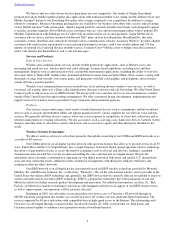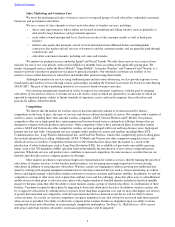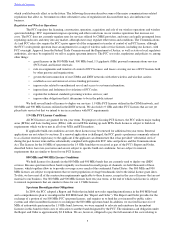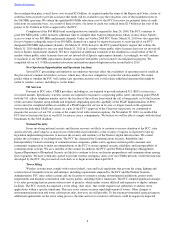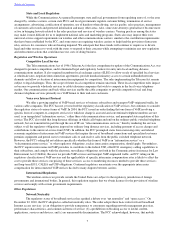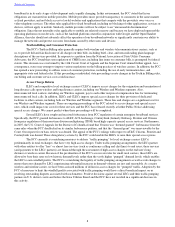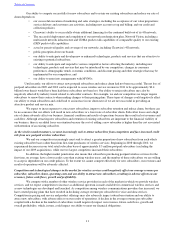Sprint - Nextel 2010 Annual Report Download - page 14
Download and view the complete annual report
Please find page 14 of the 2010 Sprint - Nextel annual report below. You can navigate through the pages in the report by either clicking on the pages listed below, or by using the keyword search tool below to find specific information within the annual report.
The wireless communications industry is experiencing significant technological change, including improvements in
the capacity and quality of digital technology and the deployment of unlicensed spectrum devices. This change causes
uncertainty about future subscriber demand for our wireless services and the prices that we will be able to charge for these
services. Spending by our competitors on new wireless services and network improvements could enable our competitors to
obtain a competitive advantage with new technologies or enhancements that we do not offer. Rapid change in technology may
lead to the development of wireless communications technologies, products or alternative services that are superior to our
technologies, products,or services or that consumers prefer over ours. If we are unable to meet future advances in competing
technologies on a timely basis, or at an acceptable cost, we may not be able to compete effectively and could lose subscribers to
our competitors.
Mergers or other business combinations involving our competitors and new entrants, including new wholesale
relationships, beginning to offer wireless services may also continue to increase competition. These wireless operators may be
able to offer subscribers network features or products and services not offered by us, coverage in areas not served by either of
our wireless networks or pricing plans that are lower than those offered by us, all of which would negatively affect our average
revenue per subscriber, subscriber churn, ability to attract new subscribers, and operating costs. For example, AT&T, Verizon
and T-Mobile now offer competitive wireless services packaged with local and long distance voice and high-speed Internet
services, and flat rate voice and data plans. Our prepaid services compete with several regional carriers, including Metro PCS
and Leap Wireless, which offer competitively-priced prepaid calling plans that include unlimited local calling. In addition, we
may lose subscribers of our higher priced plans to our prepaid offerings.
Several wireless equipment vendors, including Motorola, which supplies equipment for our push-to-talk services,
have begun to offer wireless equipment that is capable of providing push-to-talk services that are designed to compete with our
current push-to-talk services. Several of our competitors have introduced devices that are capable of providing push-to-talk
services. We announced a major network modernization plan in December 2010, Network Vision; one component of Network
Vision is the deployment of push-to-talk technology through the use of multi-modal technology on a single integrated network.
If our efforts to deploy such technology are not achieved, we may not be able to successfully compete for such services. See
“The success of our network modernization plan, Network Vision, will depend on the timing, extent and cost of
implementation; the performance of third-parties; upgrade requirements; and the availability and reliability of the various
technologies required to provide such modernization.”
The success of our network modernization plan, Network Vision, will depend on the timing, extent and cost of
implementation; the performance of third-parties; upgrade requirements; and the availability and reliability of the various
technologies required to provide such modernization.
We are implementing Network Vision, which is a multi-year initiative intended to reduce operating costs and provide
customers with an enhanced network experience by improving voice quality and faster data speeds, while creating network
flexibility and improving environmental sustainability. The focus of the plan is on upgrading the existing Sprint networks and
providing flexibility for new 4G technologies. If Network Vision does not provide an enhanced network experience or is unable
to provide CDMA push-to-talk capabilities of comparable quality to our existing iDEN push-to-talk capabilities, our ability to
provide enhanced wireless services to our customers, to retain and attract customers, and to maintain and grow our customer
revenues could be adversely affected.
Using a new and sophisticated technology on a very large scale entails risks. Should implementation of our upgraded
network be delayed or costs exceed expected amounts, our margins would be adversely affected and such effects could be
material. Should the delivery of services expected to be deployed on our upgraded network be delayed due to technological
constraints, performance of third-party suppliers, or other reasons, the cost of providing such services could become higher
than expected, which could result in higher costs to customers, potentially resulting in decisions to purchase services from our
competitors adversely affecting our revenues, profitability and cash flow from operations.
Failure to complete development, testing and deployment of new technology that supports new services could affect our
ability to compete in the industry. The deployment of new technology and new service offerings could result in network
degradation or the loss of subscribers. In addition, the technology we use, including WiMAX, may place us at a competitive
disadvantage.
We develop, test and deploy various new technologies and support systems intended to enhance our competitiveness
by both supporting new services and features and reducing the costs associated with providing those services. Successful
development and implementation of technology upgrades depend, in part, on the willingness of third parties to develop new
applications or devices in a timely manner. We may not successfully complete the development and rollout of new technology
and related features or services in a timely manner, and they may not be widely accepted by our subscribers or may not be
profitable, in which case we could not recover our investment in the technology. Deployment of technology supporting new
service offerings may also adversely affect the performance or reliability of our networks with respect to both the new and
existing services and may require us to take action like curtailing new subscribers in certain markets. Any resulting subscriber
dissatisfaction could affect our ability to retain subscribers and have an adverse effect on our results of operations and growth
Table of Contents
12


